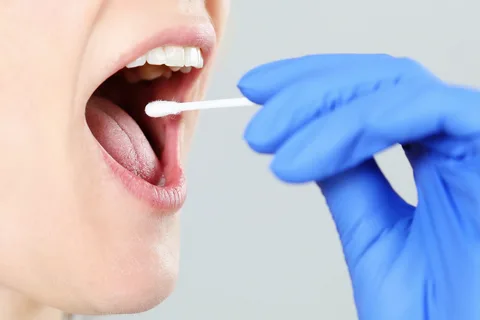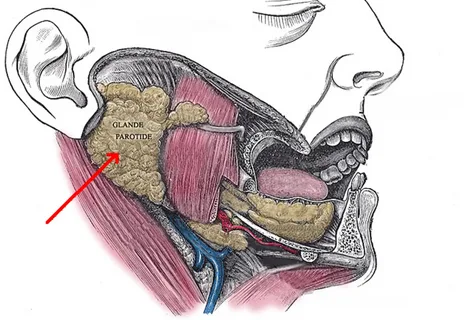Biochemistry of Saliva
Machine translation
Original article is written in RU language (link to read it) .
The health of the oral cavity organs and the hard tissues of the tooth largely depends on the amount of saliva produced and its qualitative composition. Saliva is a product of secretion by the salivary glands, which are located in the initial part of the digestive system.
A complete guide to the diagnosis and treatment of inflammatory diseases of the maxillofacial area in the online course Treatment of Inflammatory Diseases of the Maxillofacial Area: New Approaches.
In the thickness of the mucous membrane of the soft and hard palate, lips, tongue, and cheeks, there are many small salivary glands. Also, outside the oral cavity, there are three pairs of large glands:
- parotid,
- sublingual,
- submandibular.

Figure 1. Structure of the salivary gland.
The large salivary glands communicate with the oral cavity through excretory ducts. Thanks to the continuous secretion of three pairs of large salivary glands and small ones located in the thickness of the mucous membrane of the oral cavity, a person secretes from 0.5 to two liters of saliva into the oral cavity per day.
The volume of saliva secreted per day:
- submandibular glands – this is 70% of the total volume;
- parotid glands – 25%;
- sublingual glands – 4%;
- small glands account for about 1% of the total volume of saliva.
What is saliva
Saliva is a viscous fluid, with a pH of 5.8-7.4. It consists predominantly of water, which accounts for 94-99%, containing a multitude of various organic substances – 2/3 of the mass and inorganic substances – 1/3 of the mass.
The saliva that is directly secreted by the salivary glands is called ductal or own saliva. During the secretion of ductal saliva into the oral cavity, it mixes with food fragments, leukocytes, desquamated epithelium, and microorganisms enter there. Thus, whole or mixed saliva is formed. It is this saliva that washes the teeth and mucous membrane. Mixed saliva, when taken from the oral cavity for analysis, is called oral fluid.

Figure 2. Studying the composition of saliva.
How saliva is formed
Saliva production is carried out by the cells of the salivary glands, which require a large amount of energy to function. The necessary amount of energy is provided by energy-dependent processes occurring in the gland cells. ATP synthesis occurs as a result of the following biochemical processes:
- aerobic oxidation of glucose,
- breakdown of amino acids,
- β-oxidation of higher fatty acids,
- decomposition of other organic molecules.
These metabolic reactions depend on the function of the electron transfer center, which cannot operate without sufficient oxygen supply to the salivary gland cells.
Stages of Saliva Formation
First Stage
As a result of the first stage, primary saliva or primary secretion is formed. The composition of primary saliva is as follows:
- proteins,
- glycoproteins, which are synthesized by secretory (acinous cells),
- water,
- organic substances (hormones, vitamins, immunoglobulins G, A, M, medications),
- inorganic elements, which penetrate into the saliva from the blood.
The primary saliva is isotonic, with an electrolyte content identical to blood serum.

Figure 3. Salivary glands.
The transfer of various substances and elements into saliva from the blood is a selective process, determined by the functioning of a unique hemat-salivary mechanism. The structure of this mechanism is represented by the following anatomical formations:
- a network of small blood and lymphatic vessels,
- intercellular space,
- epithelial cells,
- the system of ducts of the salivary glands themselves.
This entire system is filled with lymph, blood, and interstitial fluid, complex in composition. It contains all the variety of components characteristic of the liquid fraction of blood: complex and simple proteins, lipids, carbohydrates, ions, and hormones. The transportation of substances from the blood into the glandular cell, and then into the ducts of the gland, is carried out through the following mechanisms:
- ultrafiltration – this is passive transport, transferring elements from an area of high to an area of low hydrostatic pressure,
- active transport,
- pinocytosis,
- simple and facilitated diffusion.
Second Stage
At this stage, the formation of salivary flow occurs. This process is carried out as a result of the movement of the primary secretion through the system of salivary ducts. It undergoes numerous changes, which are predominantly due to the changing content of electrolytes.
At this stage, the epithelial cells of the salivary ducts reabsorb Na+, Cl- ions from the primary secretion, produce glucose, lysozyme, some other proteins inherent in saliva, K+ ions, HCO3-, J-. The saliva that is secreted into the oral cavity is hypotonic. The movement of ions is facilitated by the following mechanisms:
- ionic channels – this is passive transport;
- with the involvement of ATPases – this is active transport.
The penetration of water into the saliva occurs through channels formed by aquaporin proteins.
Saliva Production Rate
The rate of saliva secretion is influenced to a greater or lesser extent by various factors.

Figure 4. Human salivary glands.
During the day, the rate of saliva production is variable, with an average rate of about 0.5 ml per minute, decreasing at night to 0.1 ml per minute, but can exceed 2.0 ml per minute when stimulated.
Factors influencing the rate of saliva secretion:
- quality composition of food (percentage of proteins, carbohydrates, lipids, salty, sour, sweet food);
- biorythms (time of day);
- hormonal balance (catecholamines – acetylcholine);
- age and gender of the patient;
- diseases of the salivary glands, general somatic diseases;
- physical and mental state;
- season of the year.
Consumption of sweet or sour taste irritants with food causes stimulation of salivation. The effect of sucrase on secretion involves the production of a thicker consistency of saliva.
Hyposalivation – an increased rate of saliva production is observed under the influence of the following factors:
- drugs,
- nicotine,
- local inflammation of the mucous membrane,
- pregnancy.
Hyposalivation – is a decrease in the rate of saliva secretion, it is observed in the case of:
- dehydration of the body,
- somatic diseases,
- febrile conditions.
Low saliva content in the oral cavity causes dryness of the latter – xerostomia.
Regulation of saliva production rate
Various systems are involved in the mechanisms of saliva secretion regulation, including parasympathetic and sympathetic innervation, humoral regulation, and the influence of neuropeptides:
- adrenaline and noradrenaline, components of sympathetic innervation, have a stimulating effect on the secretion of more viscous and thick consistency saliva, while the composition of the saliva will contain a minimal amount of salts and characteristic organic substances;
- acetylcholine, parasympathetic innervation, stimulates the production of a large amount of saliva, and its composition will be rich in various salts and rich in organic substances;
- neuropeptide, substance P, is a mediator of increasing the permeability of the walls of acinar cells, which causes free movement of blood plasma proteins;
- vasoactive intestinal neuropeptide is responsible for the tone of vascular walls and the secretory capabilities of epithelial cells of the oral cavity and digestive tract.
The molecules presented above interact differently with the receptors of acinar cells. Thanks to the work of the adenylate cyclase system, the signal from norepinephrine is transmitted, leading to the stimulation of protein kinase A and the release of the contents of secretory granules into the duct of the salivary gland. Other molecules performing regulatory functions transmit signals through ion channels. There is an increase in the concentration of calcium ions in the cells, which have a stimulating effect on saliva secretion.
Study of the Qualitative and Quantitative Composition of Saliva
The study of the biochemical characteristics of saliva allows for an accurate diagnosis when suspecting diseases of the oral cavity organs, or in some somatic pathologies. Thus, a high concentration of acid phosphatase indicates the development of periodontal disease, just as a decrease in the content of lysozyme in saliva.

Figure 5. Collection of saliva for research.
When detecting an increased concentration of hydroperoxides, products of free radical oxidation, including malondialdehyde, one can assume the development of periodontitis, accompanied by cellular damage. Saliva tests are not uncommon in general medical practice as they allow the identification of some systemic diseases: hepatitis, herpesvirus infection.
About the impact of saliva on the development of tooth erosion in the webinar Tooth erosion as one of the factors of pathological wear.

/public-service/media/default/507/XVjr3_671f5ca5a4d2d.jpg)
/public-service/media/default/174/3jNvq_65311fa9e8fa0.jpg)
/public-service/media/default/169/oVhio_65311d417b778.jpg)
/public-service/media/default/168/OJhGc_65311d2b71512.jpg)